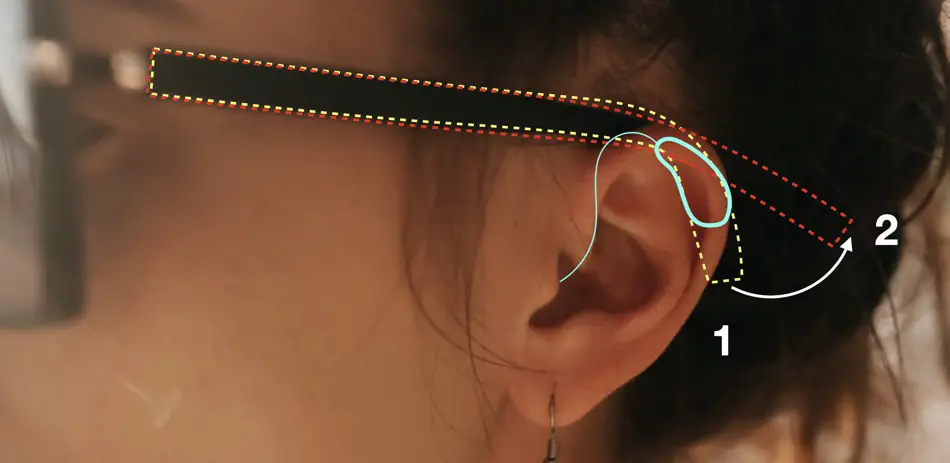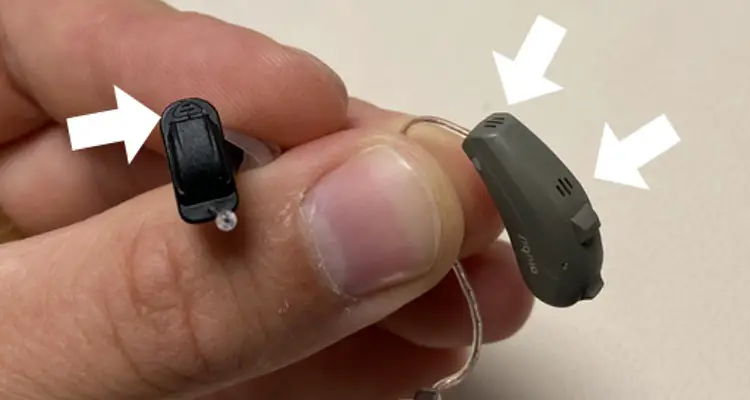Oftentimes hearing aids and glasses are worn at the same time. But when you buy each of them you seldom hear about the options you have to make the fit of both more comfortable. Here in this article you can read about the best tips for wearing hearing aids with glasses form a professional whom works in both professions daily.
In a lot of cases the comfort of wearing hearing aids with glasses can be improved with a few simple things get considered. Here in the list below you can read about them. Further down below you can get an more in depth explanation.
- Make sure to use thin temple tips with your glasses for maximum comfort
- Put glasses on first and then add the hearing aids
- Use temple tips with a holder for your hearing aids
- Make sure the temples are not placed directly on the microphones of your hearing aids
- Try different adjustment options with the temples of your glasses to make more room for the hearing aids
Hearing aids in themselves are electronic devices that seldom get modified after you bought them. With glasses, however, modifications can be made to make more room behind the ear and produce a more stable fit. Did you know the end pieces of your glasses can be changed? If not the next paragraphs explain in further detail what options you have.
Make Sure to Use Thin Temple Tips With Your Glasses for Maximum Comfort
When you wear glasses and hearing aids depending on the size and shape of them behind your ears it can get a little cramped. The thickness of the temple tips usually varies from 2-5mm. There are very thin frames available mostly out of titanium which in most cases work great with behind-the-ear hearing aids. Those titanium glasses frames as seen below are so thin because they have no additional plastic surrounding them.

But in most cases, new glasses are not necessary. When you have a plastic frame that is typically a bit thicker than its metal counterparts. But when the plastic frame is made out of acetate they have a metal inlay. This enables the optician to cut off the plastic part of the temple surrounding the metal and mounting a thinner temple tip on it.
In some cases the optician could also make the temple a little thinner by rasping the material a bit. When the thickness is reduced by half a millimeter up to a millimeter most people notice. Wearing glasses and hearing aids now feels less cramped behind the ears.
In most cases, the narrow point is on top of the ear. Here the tubes/cables of behind the ear hearing aids and the temples of glasses come together. When the narrow point sits a little lower than that a slight adjustment of the temples might be enough to improve the fitting. Down below you can see an illustration of this adjustment.

When the temples of the glasses are directly adjusted so they are resting on the ear root like shown here in position one in the illustration space gets minimized for the hearing aid. Oftentimes it is ok to adjust the temples a little straighter and bend them more towards the curve of the head for a good fit. This makes more room for the lower part of the hearing aids which are oftentimes a little thicker because the batteries sit there.
Put Glasses on First and Then Add the Hearing Aids
A lot of glasses have spring hinges which snap a little on your head. This provides a little tension for a good fit. In comparison hearing aids just rest on your ear. This one reason why it makes sense to put glasses on first. In addition to the little tension the bearing surface of temples is bigger.
So the pressure gets distributed more evenly when you put the glasses on first. When the hearing aid sits between your head and the glasses the pressure will be distributed in a more uneven way. This could lead to a foreign body sensation as well as a less stable fit of the glasses.
Use Temple Tips With a Holder for Your Hearing Aids
This is nothing we fit daily in our shop but some customers really like this solution to secure their hearing aids. In most case hearing aids do not sit snug behind your ear. Behind-the-ear hearing aids just rest on the ear. One way to secure the hearing aid would be to produce a custom ear mold that provides a more secure fit But due to the bigger size a lot of hearing aid wearers do not want this.
Instead, we made temple tips with a holder for hearing aids. This solution provides a more stable fit and secures the hearing aids nicely. Even when a face mask is put on or off the hearing aids will not leave their position. But oftentimes with RIC hearing aids a longer cable needs to be used because the hearing aid sits in a position that is a little higher.

Make Sure the Temples Are Not Placed Directly on the Microphones of Your Hearing Aids
There are some elements on a hearing aid that should not be covered by glasses. Your hearing aid has two little slots. underneath the slits are the microphones located. When the glasses cover this element the sound waves can not reach the microphone optimally. They are also why the hearing aids should be put on after your glasses.
Other elements on your hearing aid are buttons to control the volume or to switch programs that could be covered. In the picture below you can see the microphones. The hearing aid on the left side is an in-ear-variant that is never touched by your glasses. On the right side, a really small behind-the-ear hearing aid is shown. Both have smaller 10 Batteries.

So when your current hearing aids feel a little tight in combination with glasses behind your ears opt for the smaller batteries because then the whole device will be very small. This is true for in-ear as well as behind-the-ear hearing aids.
Here you have my tips for wearing glasses with hearing aids. When you buy glasses or hearing aids always have the other part with you so you can try different variants and you can then decide which one you like best.
I wish you a great day.
